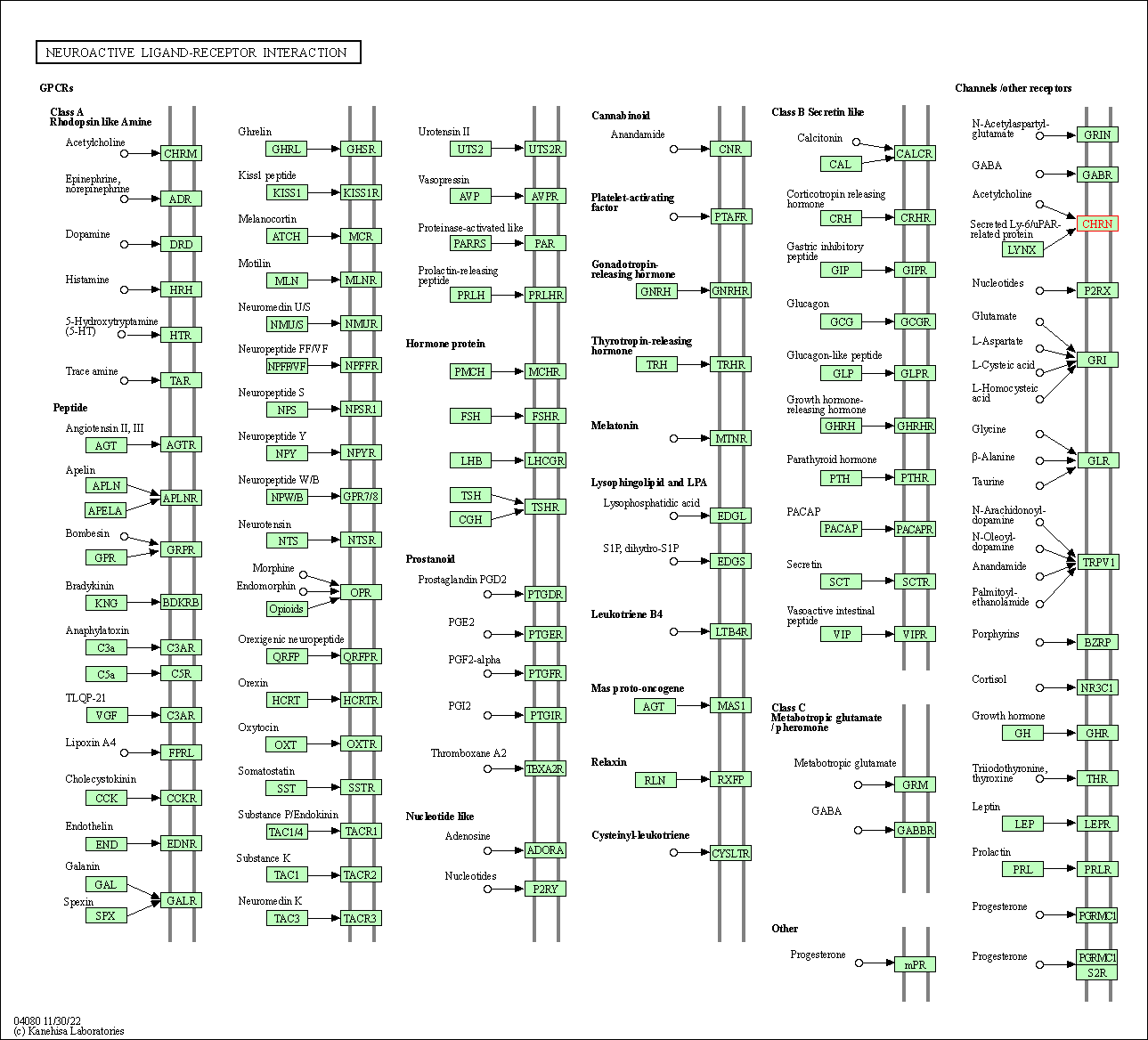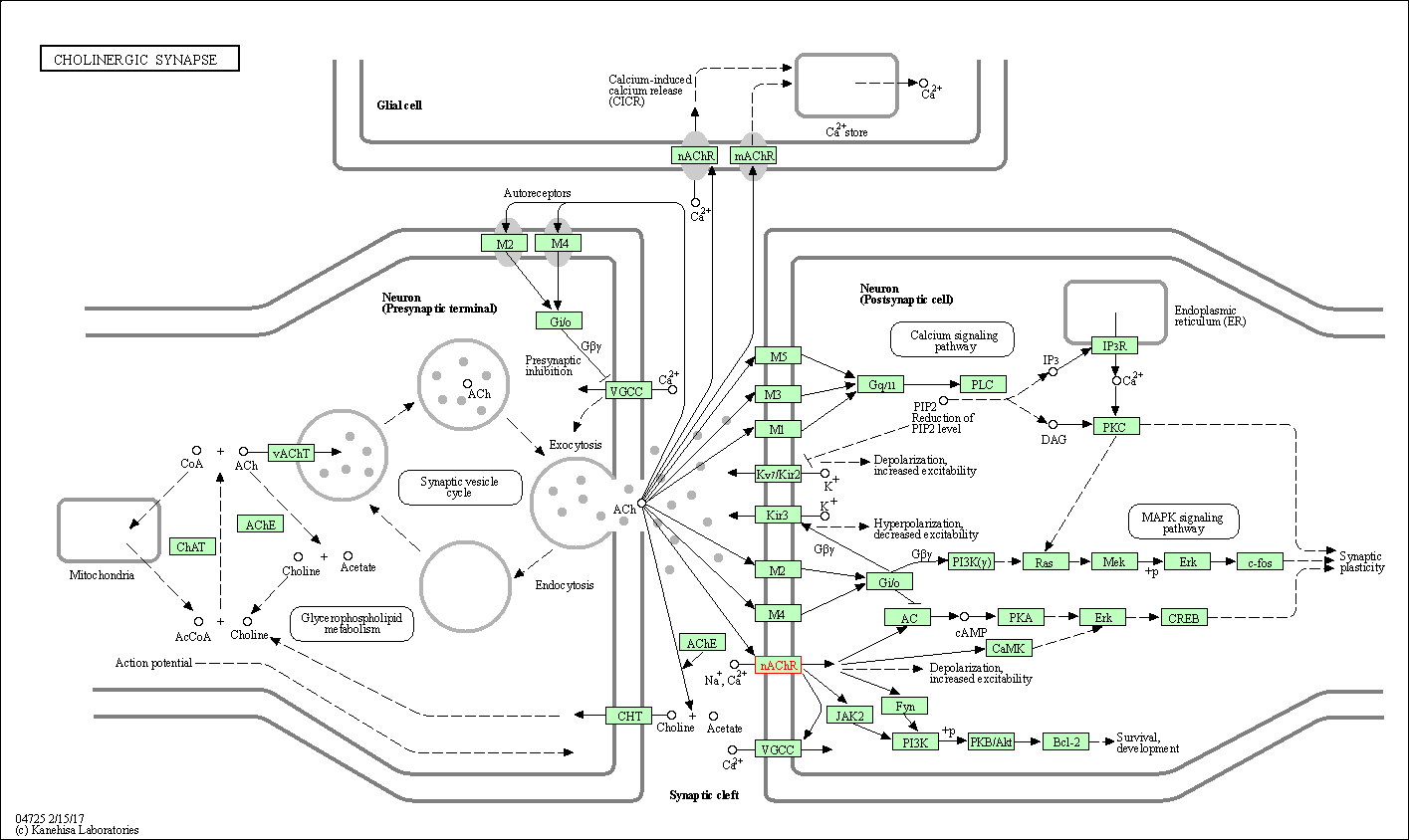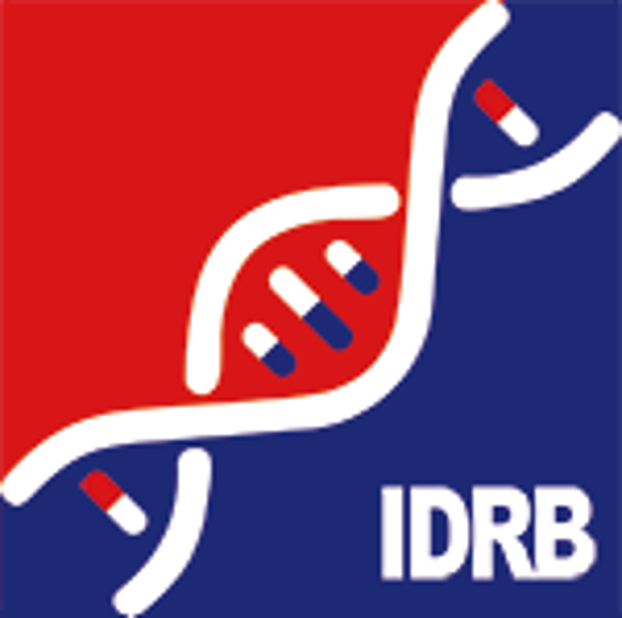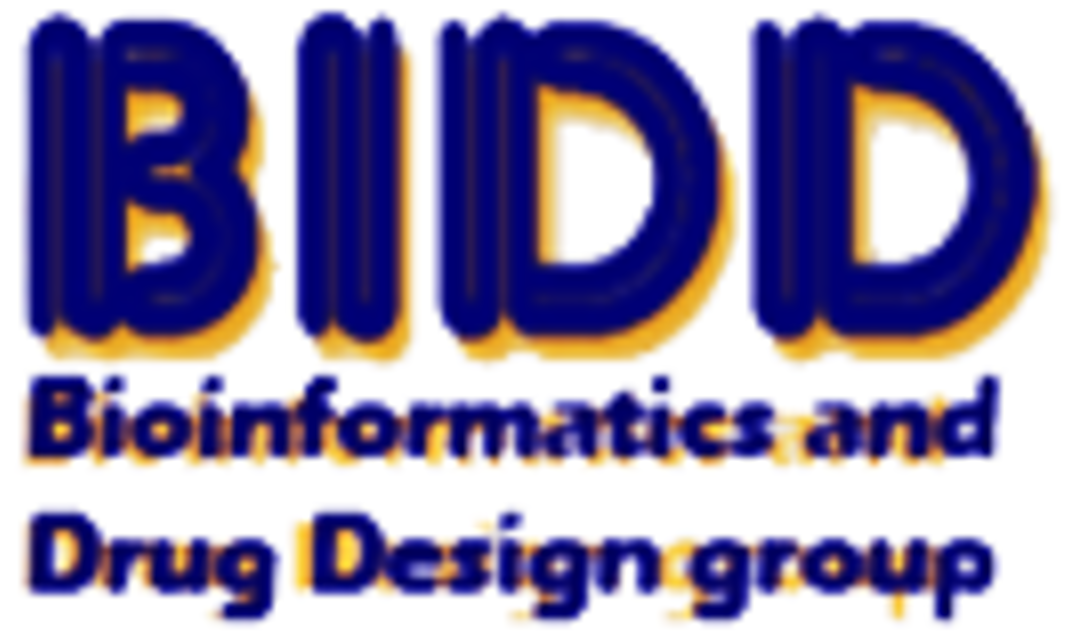Target Information
| Target General Information | Top | |||||
|---|---|---|---|---|---|---|
| Target ID |
T70967
(Former ID: TTDS00141)
|
|||||
| Target Name |
Neuronal acetylcholine receptor alpha-4 (CHRNA4)
|
|||||
| Synonyms |
Nicotinic acetylcholine receptor alpha4; CHRNA4; Alpha-4 nAChR
Click to Show/Hide
|
|||||
| Gene Name |
CHRNA4
|
|||||
| Target Type |
Successful target
|
[1] | ||||
| Disease | [+] 3 Target-related Diseases | + | ||||
| 1 | Aneurysm/dissection [ICD-11: BD50] | |||||
| 2 | Hypertensive crisis [ICD-11: BA03] | |||||
| 3 | Hypotension [ICD-11: BA20-BA21] | |||||
| Function |
After binding acetylcholine, the AChR responds by an extensive change in conformation that affects all subunits and leads to opening of an ion-conducting channel across the plasmamembrane permeable to sodium ions.
Click to Show/Hide
|
|||||
| BioChemical Class |
Neurotransmitter receptor
|
|||||
| UniProt ID | ||||||
| Sequence |
MELGGPGAPRLLPPLLLLLGTGLLRASSHVETRAHAEERLLKKLFSGYNKWSRPVANISD
VVLVRFGLSIAQLIDVDEKNQMMTTNVWVKQEWHDYKLRWDPADYENVTSIRIPSELIWR PDIVLYNNADGDFAVTHLTKAHLFHDGRVQWTPPAIYKSSCSIDVTFFPFDQQNCTMKFG SWTYDKAKIDLVNMHSRVDQLDFWESGEWVIVDAVGTYNTRKYECCAEIYPDITYAFVIR RLPLFYTINLIIPCLLISCLTVLVFYLPSECGEKITLCISVLLSLTVFLLLITEIIPSTS LVIPLIGEYLLFTMIFVTLSIVITVFVLNVHHRSPRTHTMPTWVRRVFLDIVPRLLLMKR PSVVKDNCRRLIESMHKMASAPRFWPEPEGEPPATSGTQSLHPPSPSFCVPLDVPAEPGP SCKSPSDQLPPQQPLEAEKASPHPSPGPCRPPHGTQAPGLAKARSLSVQHMSSPGEAVEG GVRCRSRSIQYCVPRDDAAPEADGQAAGALASRNTHSAELPPPDQPSPCKCTCKKEPSSV SPSATVKTRSTKAPPPHLPLSPALTRAVEGVQYIADHLKAEDTDFSVKEDWKYVAMVIDR IFLWMFIIVCLLGTVGLFLPPWLAGMI Click to Show/Hide
|
|||||
| 3D Structure | Click to Show 3D Structure of This Target | AlphaFold | ||||
| HIT2.0 ID | T22H7B | |||||
| Drugs and Modes of Action | Top | |||||
|---|---|---|---|---|---|---|
| Approved Drug(s) | [+] 2 Approved Drugs | + | ||||
| 1 | Pentolinium | Drug Info | Approved | Hypotension | [2] | |
| 2 | Trimethaphan | Drug Info | Approved | Aneurysm | [3], [4] | |
| Clinical Trial Drug(s) | [+] 1 Clinical Trial Drugs | + | ||||
| 1 | CYTISINE | Drug Info | Phase 3 | Tobacco dependence | [5] | |
| Discontinued Drug(s) | [+] 1 Discontinued Drugs | + | ||||
| 1 | ABT-418 | Drug Info | Discontinued in Phase 2 | Alzheimer disease | [6] | |
| Mode of Action | [+] 3 Modes of Action | + | ||||
| Antagonist | [+] 3 Antagonist drugs | + | ||||
| 1 | Pentolinium | Drug Info | [7] | |||
| 2 | Trimethaphan | Drug Info | [1] | |||
| 3 | Barbituric acid derivative | Drug Info | [15] | |||
| Inhibitor | [+] 17 Inhibitor drugs | + | ||||
| 1 | CYTISINE | Drug Info | [8] | |||
| 2 | HOMOEPIBATIDINE | Drug Info | [8] | |||
| 3 | (2S,3S)-2-(m-Tolyl)-3,5,5-trimethylmorpholin-2-ol | Drug Info | [11] | |||
| 4 | (2S,3S)-2-Phenyl-3,5,5-trimethylmorpholin-2-ol | Drug Info | [11] | |||
| 5 | 3-[2-(N,N,N-trimethylammonium)ethoxy]pyridine | Drug Info | [12] | |||
| 6 | 4-(4-butylpiperidin-1-yl)-1-o-tolylbutan-1-one | Drug Info | [13] | |||
| 7 | 6'-methylepibatidine | Drug Info | [14] | |||
| 8 | BOLDINE | Drug Info | [16] | |||
| 9 | CMI-489 | Drug Info | [14] | |||
| 10 | N,N-dimethyl(pyridin-3-yl)methanamine | Drug Info | [17] | |||
| 11 | N,N-dimethyl-2-(pyridin-3-yloxy)ethanamine | Drug Info | [17] | |||
| 12 | N,N-dimethyl-4-(pyridin-3-yl)but-3-yn-1-amine | Drug Info | [17] | |||
| 13 | N-ethyl-N-methyl-4-(pyridin-3-yl)but-3-yn-1-amine | Drug Info | [17] | |||
| 14 | N-methyl-2-(pyridin-3-yloxy)ethanamine | Drug Info | [17] | |||
| 15 | N-methyl-4-(pyridin-3-yl)but-3-yn-1-amine | Drug Info | [17] | |||
| 16 | N-methyl-N-(pyridin-3-ylmethyl)ethanamine | Drug Info | [17] | |||
| 17 | Predicentrine methiodide | Drug Info | [16] | |||
| Agonist | [+] 2 Agonist drugs | + | ||||
| 1 | ABT-418 | Drug Info | [9] | |||
| 2 | ABT-594 | Drug Info | [10] | |||
| Cell-based Target Expression Variations | Top | |||||
|---|---|---|---|---|---|---|
| Cell-based Target Expression Variations | ||||||
| Drug Binding Sites of Target | Top | |||||
|---|---|---|---|---|---|---|
| Ligand Name: Nicotine | Ligand Info | |||||
| Structure Description | Structure of the 2alpha3beta stiochiometry of the human Alpha4Beta2 nicotinic receptor | PDB:6CNJ | ||||
| Method | Electron microscopy | Resolution | 3.70 Å | Mutation | No | [18] |
| PDB Sequence |
ETRAHAEERL
14 LKKLFSGYNK24 WSRPVANISD34 VVLVRFGLSI44 AQLIDVDEKN54 QMMTTNVWVK 64 QEWHDYKLRW74 DPADYENVTS84 IRIPSELIWR94 PDIVLYNNAD104 GDFAVTHLTK 114 AHLFHDGRVQ124 WTPPAIYKSS134 CSIDVTFFPF144 DQQNCTMKFG154 SWTYDKAKID 164 LVNMHSRVDQ174 LDFWESGEWV184 IVDAVGTYNT194 RKYECCAEIY204 PDITYAFVIR 214 RLPLFYTINL224 IIPCLLISCL234 TVLVFYLPSE244 CGEKITLCIS254 VLLSLTVFLL 264 LITEIIPSTS274 LVIPLIGEYL284 LFTMIFVTLS294 IVITVFVLNV304 HHRSPRTHTM 314 PTWVRRVFLD324 IVPRLLLMKR334 FERSVKEDWK351 YVAMVIDRIF361 LWMFIIVCLL 371 GTVGLFLPPW381
|
|||||
|
|
||||||
| Click to View More Binding Site Information of This Target and Ligand Pair | ||||||
| Ligand Name: Cholesterol hemisuccinate | Ligand Info | |||||
| Structure Description | Structure of the 2alpha3beta stiochiometry of the human Alpha4Beta2 nicotinic receptor | PDB:6CNJ | ||||
| Method | Electron microscopy | Resolution | 3.70 Å | Mutation | No | [18] |
| PDB Sequence |
ETRAHAEERL
14 LKKLFSGYNK24 WSRPVANISD34 VVLVRFGLSI44 AQLIDVDEKN54 QMMTTNVWVK 64 QEWHDYKLRW74 DPADYENVTS84 IRIPSELIWR94 PDIVLYNNAD104 GDFAVTHLTK 114 AHLFHDGRVQ124 WTPPAIYKSS134 CSIDVTFFPF144 DQQNCTMKFG154 SWTYDKAKID 164 LVNMHSRVDQ174 LDFWESGEWV184 IVDAVGTYNT194 RKYECCAEIY204 PDITYAFVIR 214 RLPLFYTINL224 IIPCLLISCL234 TVLVFYLPSE244 CGEKITLCIS254 VLLSLTVFLL 264 LITEIIPSTS274 LVIPLIGEYL284 LFTMIFVTLS294 IVITVFVLNV304 HHRSPRTHTM 314 PTWVRRVFLD324 IVPRLLLMKR334 FERSVKEDWK351 YVAMVIDRIF361 LWMFIIVCLL 371 GTVGLFLPPW381
|
|||||
|
|
||||||
| Click to View More Binding Site Information of This Target and Ligand Pair | ||||||
| Click to View More Binding Site Information of This Target with Different Ligands | ||||||
| Different Human System Profiles of Target | Top |
|---|---|
|
Human Similarity Proteins
of target is determined by comparing the sequence similarity of all human proteins with the target based on BLAST. The similarity proteins for a target are defined as the proteins with E-value < 0.005 and outside the protein families of the target.
A target that has fewer human similarity proteins outside its family is commonly regarded to possess a greater capacity to avoid undesired interactions and thus increase the possibility of finding successful drugs
(Brief Bioinform, 21: 649-662, 2020).
Human Pathway Affiliation
of target is determined by the life-essential pathways provided on KEGG database. The target-affiliated pathways were defined based on the following two criteria (a) the pathways of the studied target should be life-essential for both healthy individuals and patients, and (b) the studied target should occupy an upstream position in the pathways and therefore had the ability to regulate biological function.
Targets involved in a fewer pathways have greater likelihood to be successfully developed, while those associated with more human pathways increase the chance of undesirable interferences with other human processes
(Pharmacol Rev, 58: 259-279, 2006).
Biological Network Descriptors
of target is determined based on a human protein-protein interactions (PPI) network consisting of 9,309 proteins and 52,713 PPIs, which were with a high confidence score of ≥ 0.95 collected from STRING database.
The network properties of targets based on protein-protein interactions (PPIs) have been widely adopted for the assessment of target’s druggability. Proteins with high node degree tend to have a high impact on network function through multiple interactions, while proteins with high betweenness centrality are regarded to be central for communication in interaction networks and regulate the flow of signaling information
(Front Pharmacol, 9, 1245, 2018;
Curr Opin Struct Biol. 44:134-142, 2017).
Human Similarity Proteins
Human Pathway Affiliation
Biological Network Descriptors
|
|
|
There is no similarity protein (E value < 0.005) for this target
|
| KEGG Pathway | Pathway ID | Affiliated Target | Pathway Map |
|---|---|---|---|
| Neuroactive ligand-receptor interaction | hsa04080 | Affiliated Target |

|
| Class: Environmental Information Processing => Signaling molecules and interaction | Pathway Hierarchy | ||
| Cholinergic synapse | hsa04725 | Affiliated Target |

|
| Class: Organismal Systems => Nervous system | Pathway Hierarchy | ||
| Degree | 1 | Degree centrality | 1.07E-04 | Betweenness centrality | 0.00E+00 |
|---|---|---|---|---|---|
| Closeness centrality | 1.07E-04 | Radiality | 3.98E-03 | Clustering coefficient | 0.00E+00 |
| Neighborhood connectivity | 1.00E+00 | Topological coefficient | . | Eccentricity | 1 |
| Download | Click to Download the Full PPI Network of This Target | ||||
| Drug Property Profile of Target | Top | |
|---|---|---|
| (1) Molecular Weight (mw) based Drug Clustering | (2) Octanol/Water Partition Coefficient (xlogp) based Drug Clustering | |
|
|
||
| (3) Hydrogen Bond Donor Count (hbonddonor) based Drug Clustering | (4) Hydrogen Bond Acceptor Count (hbondacc) based Drug Clustering | |
|
|
||
| (5) Rotatable Bond Count (rotbonds) based Drug Clustering | (6) Topological Polar Surface Area (polararea) based Drug Clustering | |
|
|
||
| "RO5" indicates the cutoff set by lipinski's rule of five; "D123AB" colored in GREEN denotes the no violation of any cutoff in lipinski's rule of five; "D123AB" colored in PURPLE refers to the violation of only one cutoff in lipinski's rule of five; "D123AB" colored in BLACK represents the violation of more than one cutoffs in lipinski's rule of five | ||
| Co-Targets | Top | |||||
|---|---|---|---|---|---|---|
| Co-Targets | ||||||
| Target Profiles in Patients | Top | |||||
|---|---|---|---|---|---|---|
| Target Expression Profile (TEP) | ||||||
| Target Affiliated Biological Pathways | Top | |||||
|---|---|---|---|---|---|---|
| KEGG Pathway | [+] 3 KEGG Pathways | + | ||||
| 1 | Neuroactive ligand-receptor interaction | |||||
| 2 | Cholinergic synapse | |||||
| 3 | Nicotine addiction | |||||
| Panther Pathway | [+] 2 Panther Pathways | + | ||||
| 1 | Nicotinic acetylcholine receptor signaling pathway | |||||
| 2 | Nicotine pharmacodynamics pathway | |||||
| Reactome | [+] 3 Reactome Pathways | + | ||||
| 1 | Highly sodium permeable acetylcholine nicotinic receptors | |||||
| 2 | Highly calcium permeable postsynaptic nicotinic acetylcholine receptors | |||||
| 3 | Highly calcium permeable nicotinic acetylcholine receptors | |||||
| WikiPathways | [+] 3 WikiPathways | + | ||||
| 1 | SIDS Susceptibility Pathways | |||||
| 2 | Neurotransmitter Receptor Binding And Downstream Transmission In The Postsynaptic Cell | |||||
| 3 | Nicotine Activity on Dopaminergic Neurons | |||||
| Target-Related Models and Studies | Top | |||||
|---|---|---|---|---|---|---|
| Target Validation | ||||||
| References | Top | |||||
|---|---|---|---|---|---|---|
| REF 1 | Mechanism of long-lasting block of ganglion nicotinic receptors by mono-ammonium compounds with long aliphatic chain. J Auton Nerv Syst. 1994 Aug;48(3):231-40. | |||||
| REF 2 | Drug information of Pentolinium, 2008. eduDrugs. | |||||
| REF 3 | Drug information of Trimethaphan, 2008. eduDrugs. | |||||
| REF 4 | Drugs@FDA. U.S. Food and Drug Administration. U.S. Department of Health & Human Services. 2015 | |||||
| REF 5 | Clinical pipeline report, company report or official report of the Pharmaceutical Research and Manufacturers of America (PhRMA) | |||||
| REF 6 | Trusted, scientifically sound profiles of drug programs, clinical trials, safety reports, and company deals, written by scientists. Springer. 2015. Adis Insight (drug id 800004036) | |||||
| REF 7 | Nicotinic and nonnicotinic receptor-mediated actions of vinblastine. Proc Soc Exp Biol Med. 1993 Jul;203(3):372-6. | |||||
| REF 8 | Epibatidine isomers and analogues: structure-activity relationships. Bioorg Med Chem Lett. 2006 Nov 1;16(21):5493-7. | |||||
| REF 9 | (S)-3-methyl-5-(1-methyl-2-pyrrolidinyl)isoxazole (ABT 418): a novel cholinergic ligand with cognition-enhancing and anxiolytic activities: II. In vivo characterization. J Pharmacol Exp Ther. 1994 Jul;270(1):319-28. | |||||
| REF 10 | The nicotinic acetylcholine receptor agonist ABT-594 increases FGF-2 expression in various rat brain regions. Neuroreport. 1999 Dec 16;10(18):3909-13. | |||||
| REF 11 | Synthesis and characterization of in vitro and in vivo profiles of hydroxybupropion analogues: aids to smoking cessation. J Med Chem. 2010 Jun 24;53(12):4731-48. | |||||
| REF 12 | Aryloxyethylamines: binding at alpha7 nicotinic acetylcholine receptors. Bioorg Med Chem Lett. 2006 Aug 15;16(16):4283-6. | |||||
| REF 13 | Discovery of N-{1-[3-(3-oxo-2,3-dihydrobenzo[1,4]oxazin-4-yl)propyl]piperidin-4-yl}-2-phenylacetamide (Lu AE51090): an allosteric muscarinic M1 rec... J Med Chem. 2010 Sep 9;53(17):6386-97. | |||||
| REF 14 | Synthesis and nicotinic acetylcholine receptor binding properties of bridged and fused ring analogues of epibatidine. J Med Chem. 2007 Dec 13;50(25):6383-91. | |||||
| REF 15 | Whiting PJ: The GABAA receptor gene family: new opportunities for drug development. Curr Opin Drug Discov Devel. 2003 Sep;6(5):648-57. | |||||
| REF 16 | Aporphine metho salts as neuronal nicotinic acetylcholine receptor blockers. Bioorg Med Chem. 2007 May 15;15(10):3368-72. | |||||
| REF 17 | Synthesis and analgesic activity of secondary amine analogues of pyridylmethylamine and positional isomeric analogues of ABT-594. Bioorg Med Chem Lett. 2006 Apr 1;16(7):2013-6. | |||||
| REF 18 | Structural principles of distinct assemblies of the human Alpha4beta2 nicotinic receptor. Nature. 2018 May;557(7704):261-265. | |||||
If You Find Any Error in Data or Bug in Web Service, Please Kindly Report It to Dr. Zhou and Dr. Zhang.

